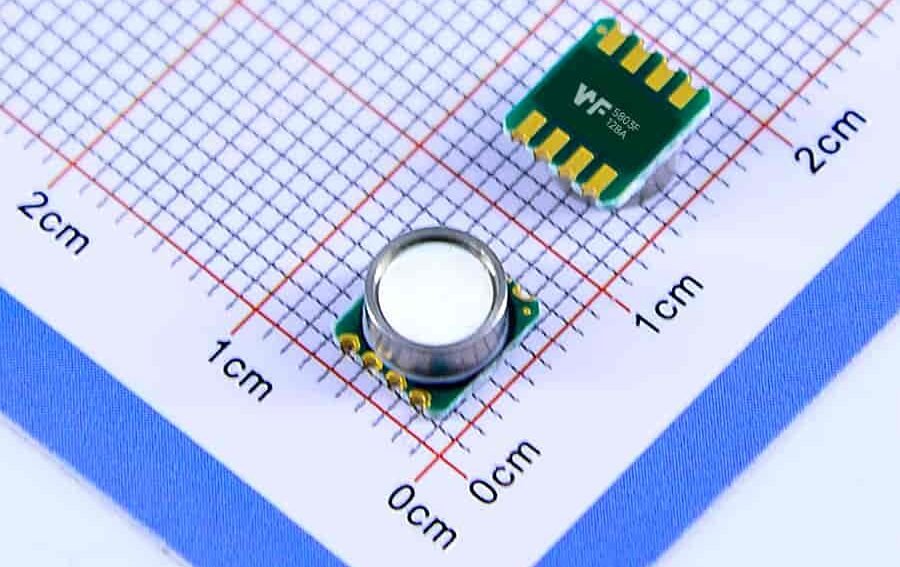Mobile air pressure sensors are low-power MEMS devices that act as environmental sensing sensors, picking up tiny pressure changes and converting them into altitude, weather trends or signs of seal failure. When you fuse pressure data with GPS, accelerometers, gyros and Wi-Fi/BLE, devices gain more reliable altitude readings, finer floor detection and short-term weather alerts.
Katalog
1. Accurate altitude measurement and height tracking
1.1 Technical and application overview
Combine a pressure sensor with GPS and filtering, and you can improve altitude accuracy from GPS-only ±10 m to roughly ±1 m, which really helps in urban canyons or where GPS is weak. For smartwatches, pressure shifts can count floors or stairs (about 0.1 hPa per floor); for drones, the sensor gives hold-height feedback to keep hover stable. When integrating, watch sensor resolution, temperature-drift compensation and sampling rate to keep vertical estimates continuous and accurate.
1.2 Integration and implementation points
When choosing a pressure sensor for mobile kit, check its resolution and long-term stability; temperature compensation and packaging directly affect altitude accuracy. Fuse GPS and IMU data to cut transient errors, and balance sampling strategy against power draw to manage responsiveness and battery life. Physically, avoid dead volumes or chassis delays; in software, implement baseline pressure estimation and spike filtering.

2. Environmental sensing and weather support
2.1 Pressure trends and local prediction
Recording pressure trends locally lets a device infer short-term weather — a sudden drop often hints at rain. Using the pressure sensor as an on-device weather signal reduces reliance on cloud services and speeds up alerts. Pressure readings can also trigger environment-adaptive modes, like power management or thermal tweaks for high-altitude use. In practice, balance sampling rate with power consumption and apply temperature calibration to keep the sensing reliable and interpretable.
2.2 Device environmental adaptation
When pressure data drives device settings, set thresholds and verification rules to avoid false triggers. In the field, combine historical pressure curves with other sensors (temperature, humidity, location) for robust local weather cues and device self-adjustment.
3. Vertical enhancement for indoor positioning and navigation
3.1 Floor detection and vertical positioning
Inside multi-storey buildings, pressure sensors paired with Wi-Fi/BLE can achieve floor-level vertical positioning, letting AR navigation or indoor maps clearly distinguish levels (for example, B1 vs 1). Fitness tracking apps can use pressure to correct elevation changes and produce truer 3D routes. Key aspects include dynamic baseline pressure estimation, handling short-term pressure drift and mapping pressure changes to floor heights so positioning stays stable in complex indoor spaces.
3.2 Trajectory correction and baseline estimation
Floor mapping requires short-term baselines and detection of long-term drift. To cut false positives, systems often combine wireless fingerprinting or accelerometer events to spot floor changes; algorithms must do frequent recalibration within tight power budgets.
4. Air pressure in health and sports monitoring
4.1 High-altitude and dive monitoring
Pressure sensors can track ascent rates and flag rapid altitude gain as a possible acute mountain-sickness risk; in waterproof watches, they can feed models to estimate dive depth. Sports devices use altitude changes to give realistic climb/descent data and better training feedback. Integrators need to mind package sealing and calibration routines to avoid environmental noise causing false alarms, and fuse heart-rate and accel data in algorithms to improve alert accuracy.
4.2 Training and data fusion
A sports monitoring system should combine pressure with heart rate, stride data and GPS to produce meaningful exercise and intensity metrics. Filtering short-term noise and recognising human-made events (like lifts) are crucial in the algorithm design.
5. AR/gaming interaction and device hardware protection
5.1 Spatial modelling and interaction enhancement
Pressure data can help build AR height models so virtual objects sit correctly relative to terrain; games can use simulated altitude effects to boost immersion. For hardware protection, pressure sensors can spot sudden internal pressure changes that suggest seal breach or water ingress, and help manage internal/external pressure differentials in extreme environments to protect screens and batteries. Design needs to strike a balance between sensitivity and false alarms, with clear trigger thresholds and multi-sensor checks.
5.2 Seal testing and pressure balancing
Pressure-based hardware protection calls for staged verification — for instance, checking humidity or accelerations alongside pressure to reduce false positives. In harsh environments, combine structural design with pressure balancing to cut the risk of screen or battery damage from pressure differentials.
Çözüm
As a scene-enhancing sensor, the air pressure sensor gives mobile devices multi-dimensional data from altitude to environmental and safety monitoring. Fused with GPS, IMUs and wireless positioning, it noticeably improves positioning accuracy, indoor/outdoor scene recognition and short-term weather detection. The engineering priorities are sensor selection (resolution, drift, packaging), power and sampling strategies, and robust data-fusion algorithms. The WF3050D is a common mini package sensors suited to wearables and drones.
Yukarıdaki giriş, basınç sensörü teknolojisi uygulamalarının yalnızca yüzeyini çizmektedir. Çeşitli ürünlerde kullanılan farklı sensör elemanları türlerini, bunların nasıl çalıştığını, avantajlarını ve dezavantajlarını keşfetmeye devam edeceğiz. Burada tartışılanlar hakkında daha fazla ayrıntı istiyorsanız bu kılavuzun ilerleyen bölümlerindeki ilgili içeriğe göz atabilirsiniz. Eğer vaktiniz kısıtlıysa bu kılavuzun detaylarını indirmek için buraya da tıklayabilirsiniz. Hava Basınç Sensörü Ürünü PDF verileri.
Diğer sensör teknolojileri hakkında daha fazla bilgi için lütfen Sensörler sayfamızı ziyaret edin.


